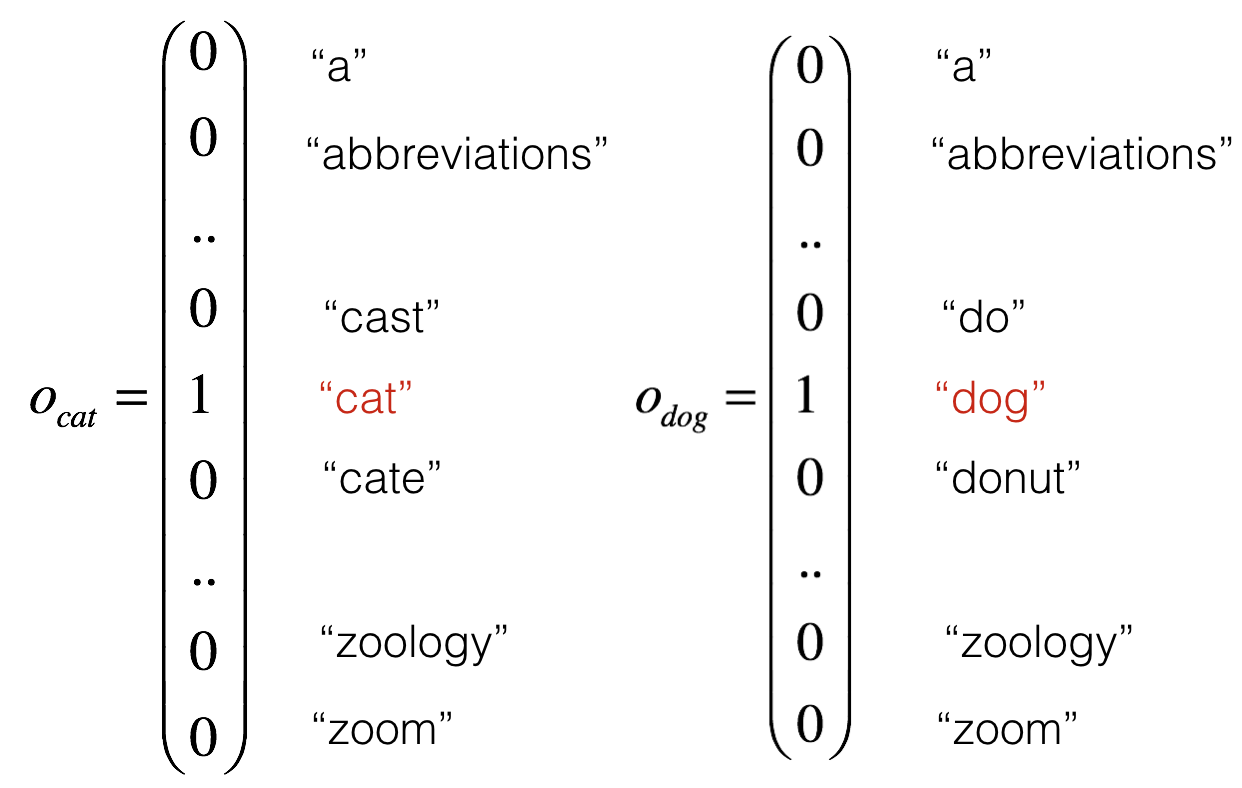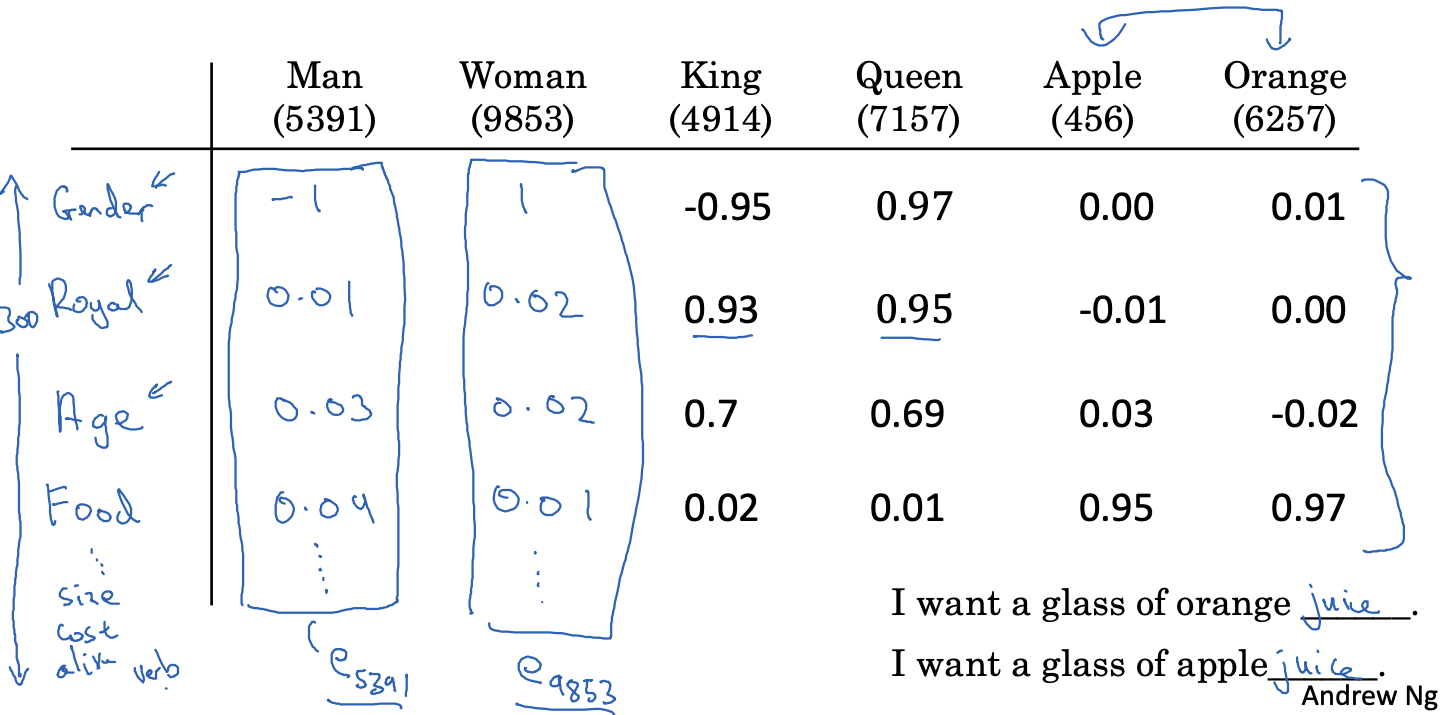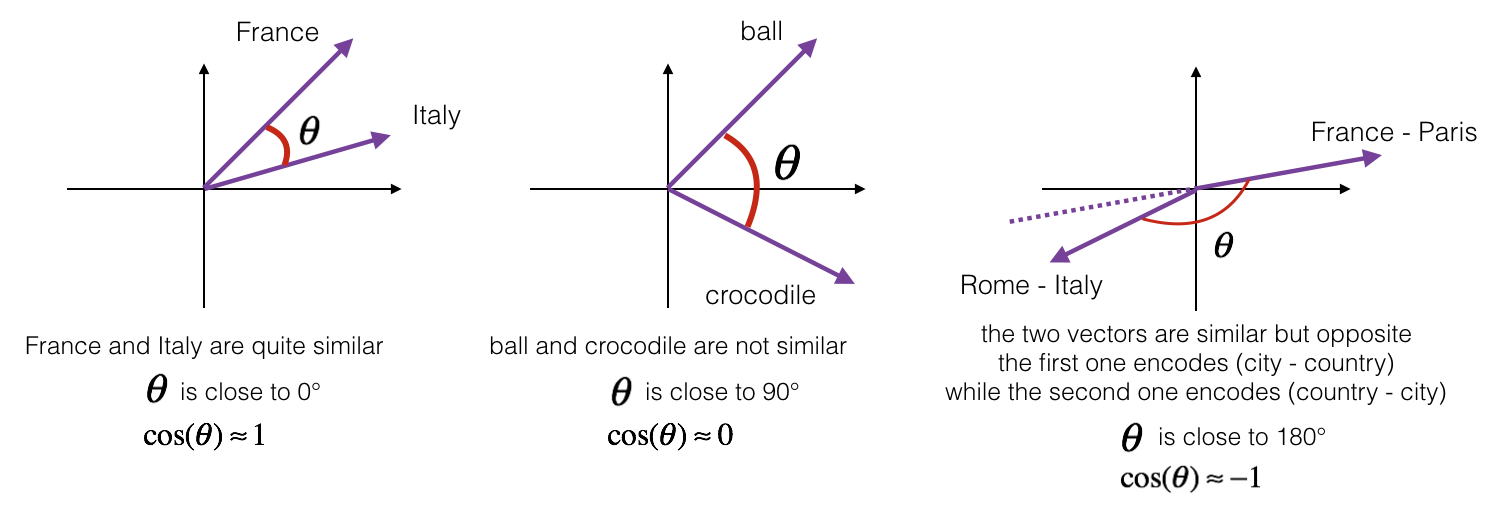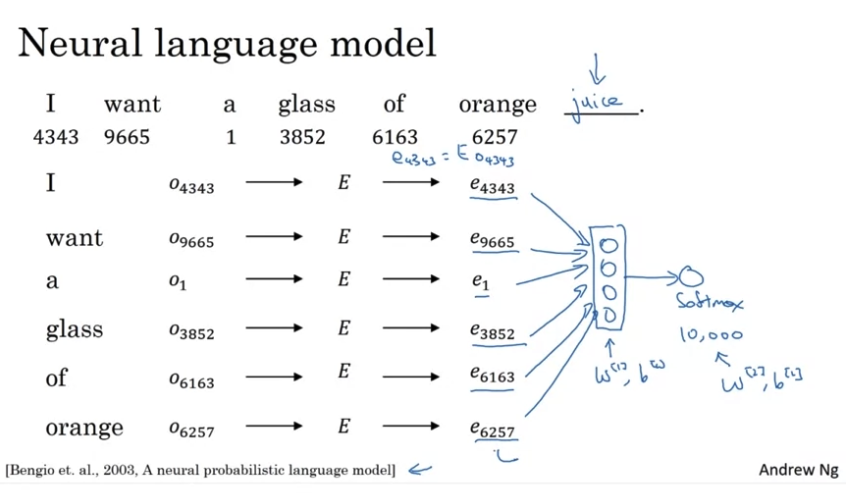Word Embeddings
Word Embeddings
之前我们将输入文本用一个 1 hot vector 来表示,它是建立在一个 dictionary 的基础上,比如单词cat的表示方式为
[0, 0, 0, ..., 1, ..., 0, 0]
1表示其在 dictionary 中的 index,我们用$O_{index}$表示。上面例子中,cat在字典中的 index 为 5791,则对应的表示为${O_{5791}}$。

不难发现,对任意两个不同的 word,他们所对应向量之间的 inner product 为0。这说明 word 之间完全正交,即使他们有相关性,系统也无法 generalize,例如
I want a glass of orange juice
I want a glass of apple ____
即使系统可以推测出orange juice,但是当下次遇到 apple时,由于apple和orange正交,则之前的结果无法 generalize 到 apple 上面,此时还需要计算得到 apple juice,效率非常低。因此我们可以换一种形式来表示一个 word。
我们可以给字典里的每个 word 关联一些 feature,比如

图中我们为每个 word 关联了 300 个 feature,因此每个 word 可以用一个[300, 1]的 vector 表示,对于单词Man所对应的 vector,我们用 $e_{5391}$ 来表示。这样两个相似的 word,他们的 feature vector 也是相似的,比如Apple和Orange。
回到最开始 RNN 的那个例子,假设我们有一个句子,我们需要识别出那些 word 是人名
x = ["Sally", "Johnson", "is", "an", "orange", "farmer"]
y = [1, 1, 0, 0, 0, 0]
之前每个 word 使用 1 hot vector 来表示,现在则可以用 word embedding 来表示。那么 word embedding 从哪里来呢?我们需要自己训练 model 来得到每个 word 的 embedding。另一种方式是下载已经训练好的embedding model。对于每个 word 来说,我们可以想象将其 encode 成一个 vector,vector中的每个值代表一个描述这个词的feature或者一个单独的dimenson。embedding就是这些vector的集合。
在实际应用中,我们可以用一个很大的 unlabeled text 数据集来 train 我们的 embedding model,然后在 transfer learning 到一个 small dataset 上面:
- Learn word embeddings from a large text corpus (1-100B words), or download a pre-trained embedding online
- Transfer embedding to new task with smaller training set (say, 100k words)
- Optional: Continue to fine tune the word embeddings with new data.
回到前面说的相关性问题,当我们将word映射成embedding vector之后,我们如何来描述各个vector之间的相关性呢?一种方法是使用 Cosine Similarity,即给定两个vector $u$和$v$,计算下面式子
\[\text{CosineSimilarity(u, v)} = \frac {u \cdot v} {||u||_2 ||v||_2} = cos(\theta)\]Cosine Similarity 的值取决于$u$, $v$之间的夹角。如果$u$, $v$相似度越高,那么它们之间的夹角越趋向于0(cosine值趋向于1),反之,则夹角趋向于90甚至180度

Appendix #1 展示了如何用Python计算两个vector的相似度。除了使用余弦相似度以外,也可以使用L2范数(欧几里得距离),这里不展开讨论
由之前的Computer Graphic文章可知,Cosine Similarity的代数表达为两个vector的点积(Dot Product)。因此,我们通常用点积来描述两个embedding vector在 多维空间的相似度,如果点积的值越大,则表示它们在语义上越接近,反之则越疏远,这点和cosine的表达是类似的。
Embedding Matrix
假设我们的字典有10,000个单词,每个单词的 feature vector 是[300, 1],那么整个 embedding matrix 为[300, 10,000],每一个列向量代表一个词所有的 feature,我们的目标就是 train 我们的 network 来找到这个 embedding matrix
如果我们用这个 embedding matrix E (300, 10,000) 去和一个 one-hot vector O(10,000, 1)相乘,结果是一个(300, 1)的 vector e

Word2Vec
Word2Vec 是一种相对比较高效的 learn word embedding 的一种算法。它的大概意思,选取一个 context word,比如”orange” 和一个 target word 比如 “juice”,我们通过构建 neural network 找到将 context word 映射成 target word 的 embedding matrix。通常来说,这个 target word 是 context word 附近的一个 word,可以是 context word 向前或者向后 skip 若干个 random word 之后得到的 word。
如果从 model 的角度来来说,它的 input 是一个 word,output 是它周围的一个 context word。
还是假定我们的字典大小为10,000,每个 feature vector 的 dim 是300,那么 embedding 的 matrix 大小为[10,000, 300],我们的输入用 word 的 1-hot vector 表示,即是一个[10,000, 1]的稀疏向量,则我们 model 定义如下
# for each input word, predict its context words surrounding it
class SkipGram(nn.Module):
def __init__(self, n_vocab, n_embed):
super().__init__()
# complete this SkipGram model
self.embedding = nn.Embedding(n_vocab, n_embed)
self.fc = nn.Linear(n_embed, n_vocab)
self.softmax = nn.LogSoftmax(dim=1)
def forward(self, x):
x = self.embedding(x)
x = self.fc(x)
x = self.softmax(x)
return x
Negative Sampling
上面的SkipGram有一个性能问题是如果字典数量过大会导致 softmax 方法非常耗时。这里介绍另一种相对高效的 network,叫做 Negtive Sampling。它的大概意思是,给一组 context word 和 target word,判断他们是否是符合语义,比如
x1: (orange, juice), y1:1
x2: (orange, king), y2:0
选取这个 pair 的方式和上面一样,sample 一下 context word,然后随机选取某一个 context word 周围一个 word(window 可以是左右 10 个 word 以内)作为 target word。
因此,我们 model 变成了一个 logistic regression model,它的 input 是一个 pair,output 是0或1用来表示这个 pair 是否正确。
context_embed = nn.Embedding(n_vocab, n_embed)
target_embed = nn.Embedding(n_vocab, n_embed)
P(y=1 | c,t) = sigmoid(target_embed.t() * context_embed)
当我们 train 这个 model 的时候,我们的 training dataset 需要有 negative examples:
context | word | target?
--------------------------
orange | juice | 1
range | king | 0
orange | book | 0
orange | the | 0
orange | of | 0
但实际上我们 train 的时候,y不需要包含 10,000 个结果,而只需要K个,其中K-1个为 negative example,K可以为 4
Resources
- The Unreasonable Effectiveness of Recurrent Neural Networks
- Deep Learning Specialization Course on Coursera
- Deep Learning with PyTorch
Appendix #1: cosine_similarity
def cosine_similarity(u, v):
"""
Cosine similarity reflects the degree of similarity between u and v
Arguments:
u -- a word vector of shape (n,)
v -- a word vector of shape (n,)
Returns:
cosine_similarity -- the cosine similarity between u and v defined by the formula above.
"""
# Special case. Consider the case u = [0, 0], v=[0, 0]
if np.all(u == v):
return 1
dot = np.sum(u*v)
# Compute the L2 norm of u
norm_u = np.sqrt(np.sum(u**2))
# Compute the L2 norm of v (≈1 line)
norm_v = np.sqrt(np.sum(v**2))
# Avoid division by 0
if np.isclose(norm_u * norm_v, 0, atol=1e-32):
return 0
# Compute the cosine similarity defined by formula
cosine_similarity = dot/(norm_u * norm_v)
return cosine_similarity
def cosine_similarity_test():
father = word_to_vec_map["father"]
mother = word_to_vec_map["mother"]
ball = word_to_vec_map["ball"]
crocodile = word_to_vec_map["crocodile"]
france = word_to_vec_map["france"]
italy = word_to_vec_map["italy"]
paris = word_to_vec_map["paris"]
rome = word_to_vec_map["rome"]
cosine_similarity(father, mother) # 0.8909038442893616
cosine_similarity(ball, crocodile) # 0.2743924626137942
cosine_similarity(france - paris, rome - italy) # -0.6751479308174201
